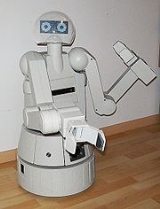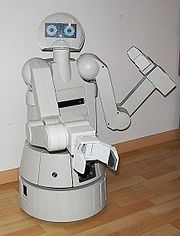
Modulus robot
Encyclopedia

Domestic robot
A domestic robot is a robot used for household chores. Thus far, there are only a few limited models, though science fiction writers and other speculators have suggested that they could become more common in the future...
Modulus, described by the manufacturer as "the friend of homo sapiens", was made by Sirius, a company Massimo Giuliana set up in 1982 for marketing home and personal computer
Personal computer
A personal computer is any general-purpose computer whose size, capabilities, and original sales price make it useful for individuals, and which is intended to be operated directly by an end-user with no intervening computer operator...
s, and which decided to start building its own domestic robot back in 1984. When the first "Modulus" prototype had been realized, the company asked Isao Hosoe, a Japanese designer who has been living and working in Milan
Milan
Milan is the second-largest city in Italy and the capital city of the region of Lombardy and of the province of Milan. The city proper has a population of about 1.3 million, while its urban area, roughly coinciding with its administrative province and the bordering Province of Monza and Brianza ,...
for many years, to study its "body-work". Hosoe's work, however, went well beyond this, and was followed by a complete technological reprocessing of the robot. Data Process was responsible for the design and manufacture of the electronic and mechanical parts, while Sirius used the expertise of an American company, the Robot Sciences Corporation, for the software (its founder, Joseph H. Bosworth, is known by some as "the father of personal robotics").
Development
Two million dollars were invested in developing this particular piece of equipment. Research carried out in the United States showed that there would be greater development in this sector. It was also estimated that the use of "Modulus" could provide an opportunity to bring back into operation many PCs that were bought during the boom, but which are not used seldom, if ever. A good slice of the "Modulus" market could consist of the owners of these personal computers, newly aware of the possibility of connecting them to a personal robot."Modulus" was designed as a robot with possible domestic applications, but in reality it is open to any future development. Modularity - hence its name - is one of its principal characteristics, and it has been designed for adaptation to the widest possible range of applications. Comparing the robot with man, "Modulus" can be said to have an electronic "circulatory system
Circulatory system
The circulatory system is an organ system that passes nutrients , gases, hormones, blood cells, etc...
" that permits the various extremities (arms, head, etc.) to communicate with the brain (CPU in a computer). The "Modulus" robots could have abilities such as a phoneme
Phoneme
In a language or dialect, a phoneme is the smallest segmental unit of sound employed to form meaningful contrasts between utterances....
s synthesizer, voice recognition
Speaker recognition
Speaker recognition is the computing task of validating a user's claimed identity using characteristics extracted from their voices .There is a difference between speaker recognition and speech recognition . These two terms are frequently confused, as is voice recognition...
, infra-red
Infrared
Infrared light is electromagnetic radiation with a wavelength longer than that of visible light, measured from the nominal edge of visible red light at 0.74 micrometres , and extending conventionally to 300 µm...
communication, etc., making it suitable for performing many functions ranging from helping to teach children to assisting the handicapped or invalids.
When studying the eventual appearance of "Modulus", Isao Hosoe began by looking at the robots of the past. These included "Electro", built by Westinghouse in 1939. Hosoe hit on the right appearance by studying human expressions and gestures, bearing in mind that a domestic robot needs to be appealing on account of its proximity to man. Its eyelids have to open, its pupils dilate or contract. It must be able to nod or shake its head, bend its torso, and raise, lower and rotate its arms. "Modulus", however, has no feet. Available in three configurations - "Base", "Service & Security" and "Moddy" - "Modulus" stands on a Base unit 35 cm in diameter and 15 cm high, two two-speed motors connected to rubber wheels, and two spherical stabilizers. It comes with a small infra-red Instrument for connecting it to another remote control
Remote control
A remote control is a component of an electronics device, most commonly a television set, used for operating the television device wirelessly from a short line-of-sight distance.The remote control is usually contracted to remote...
device or for interacting with the major home and personal computers.
Base
This first unit can be added to for different functions. As it stands it can be used in hobbies as a home computerHome computer
Home computers were a class of microcomputers entering the market in 1977, and becoming increasingly common during the 1980s. They were marketed to consumers as affordable and accessible computers that, for the first time, were intended for the use of a single nontechnical user...
, self-propelled peripheral, and can be useful for people wanting to learn to program robots. The simplest attachments which can be connected to the Base unit are a vacuum cleaner
Vacuum cleaner
A vacuum cleaner, commonly referred to as a "vacuum," is a device that uses an air pump to create a partial vacuum to suck up dust and dirt, usually from floors, and optionally from other surfaces as well. The dirt is collected by either a dustbag or a cyclone for later disposal...
and a plotter-mechanism that uses felt pens, etc., to produce drawings of considerable precision.
Service & Security
The second "Modulus" configuration, the Service Robot, is obtained by fitting the Techno-cake home-security and service unit on to the Base. One of the components allow the robot to signal the presence of smoke, gas, water, and intruders; at the first sign of danger it informs the computer or triggers a siren or preset vocal message. An arm with ample freedom of movement and considerable gripping power can be added to the Service Robot. Using its meteo-system, the robot will fetch its owners umbrella if it is going to rain; a simple whistle will bring it toddling over to you.Moddy
Moddy is the third and most advanced version of the robot. It is obtained by adding a torso, two arms, and a head to the other two units. The robot can carry a tray with its two arms. Its head and big eyes making it into a really human character, reliable, and a companion to play with. It is not surprising then if Isao Hosoe, who designed "Modulus" together with Ann Marinelli, Donato Greco, and Alessio Pozzoli, also received special advice from his two children, ten-year-old Takeo and fifteen-year-old Taro.The first two units were previously available on the market. Base complete with vacuum cleaner and plotter-mechanism, cost about a million lire, while the price of the Techno-cake varied from two to five million lire, depending on the type and number of components in function (not all the components were available yet, on account of the time needed to develop the software). It would probably take up to a year before Moddy was ready which would cost between eight and ten million lire, but unfortunately Sirius became bankrupt before the "Modulus" project could be completed, and some of the robots had to be sold to companies that distributed them for the aid of handicapped while the rest of the Moddy robots were sold to a Norwegian company called Arngren Electronics A/S where they were re-sold during the early 1990s.

